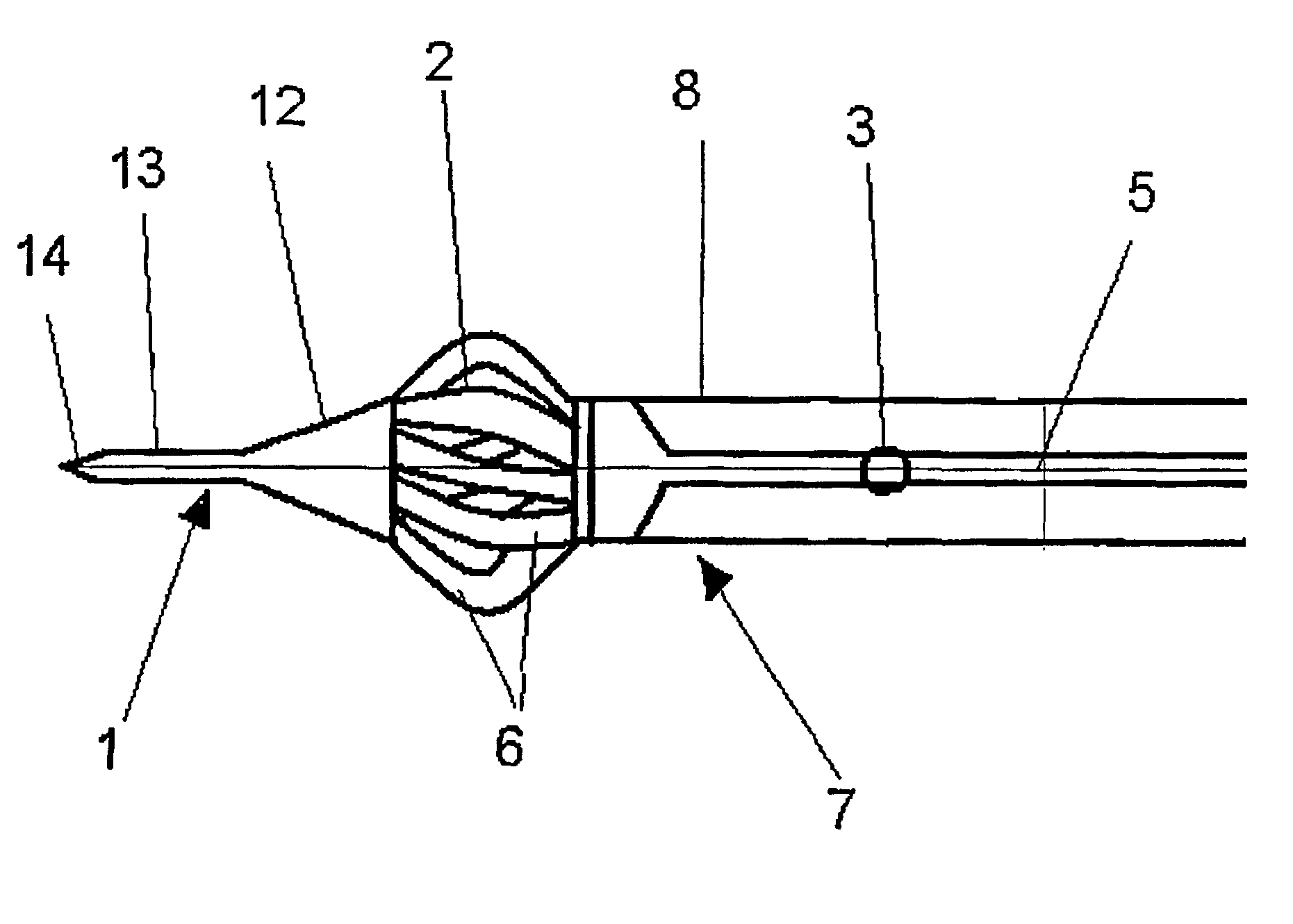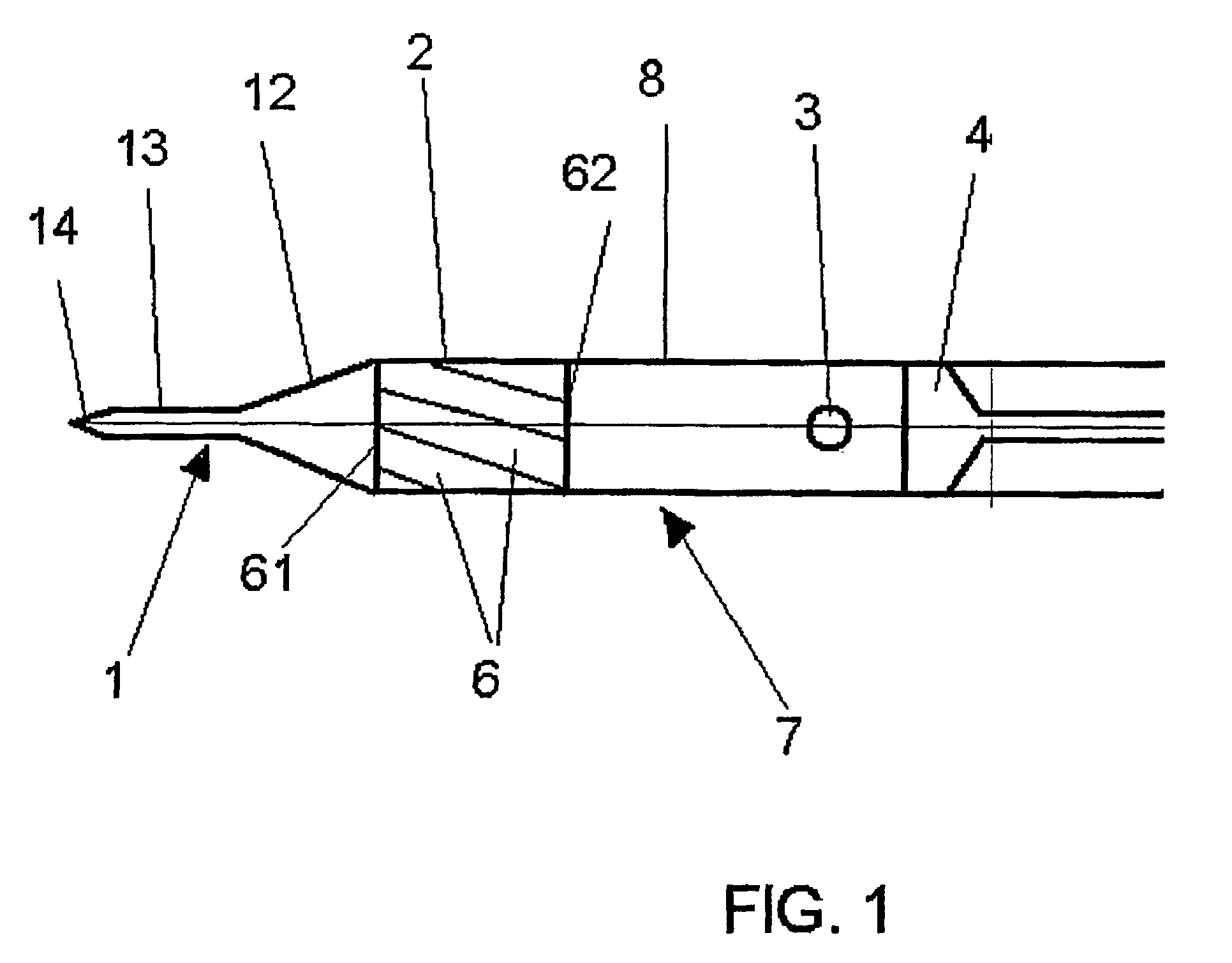[0009]The positioning element serves for positioning the apparatus and facilitates the penetration into the tissue, where it is thereby affixed. In the tubular body a space is formed between the end of the positioning element, averted to the distal end of the apparatus, and the thrust means, which serves for receiving the particles to be introduced into the tissue. If the apparatus is brought into a tense condition, which will be described later in detail, the outlet area is extended in the radial direction, whereby openings, through which the particles can emerge out of the space described above and can penetrate into the tissue, are formed between the flexible elements forming this area.
[0011]Preferably the positioning element is a needle tip. This needle tip can ensure a rapid
insertion of the apparatus into the tissue and can thus avoid a sideslip, as it would occur with an apparatus, where the
insertion would take place slowly. According to the invention, the needle tip can have a tapered portion, which extends from the outlet area to the distal end of the apparatus. In such an embodiment, the length of the tip must be chosen accordingly, in order to achieve a small increase in
diameter from the distal end to the outlet area over small axial distances. If the increase of the diameter over small axial distances would be too large, the insertion into the tissue would be more difficult.
[0014]The elements of the outlet area can have different shapes. In one embodiment the elements are formed as stripes of a flexible material and are arranged in a spiral or
helical arrangement. With such a
helical arrangement of the elements, their flexibility can be sustained. An ideally formed basket can form with such a
helical arrangement in the tense condition, if the elements are attached on both sides, i.e., towards the sleeve and the positioning element. At the position of the largest diameter, this basket exhibits the biggest distances between the stripe-shaped elements and in addition exhibits a high stability. Especially, if the apparatus should be used for inserting particles into a
cardiac muscle or any other strong
muscle tissue, it is important that this area exhibits a stability, which can withstand the
external pressure applied on the outlet area and can ensure an expansion of the tissue.
[0016]In the relaxed condition, the outlet area forms a closed area, i.e., the elements abut close to each other or overlap. In order to ensure the sealing of this area and to thereby prevent escaping of smaller particles during the insertion of the apparatus into the tissue, the apparatus can also have two
layers of elements. These two
layers are preferably formed as tubes and are radially spaced from each other. In this embodiment, the direction of the spiral winding of the elements of the inner layer can be opposite to the direction of the spiral winding of the elements of the outer layer. It is also possible to provide different angles of inclination of the spiral windings in the two
layers. By providing two layers, two tubular walls for the outlet area are formed, which prevent an undesired early escape of particles.
[0025]Basically those catheters, which are already known, can be used as catheters. The design of catheters, as well as their handling, is known in the field of medical
engineering and will therefore not be further explained at this point. The
catheter for the inventive apparatus, however, exhibits at its distal end the components of the apparatus, in particular the positioning element and the outlet area. The
guide catheter encloses the
catheter, which carries the apparatus or represents the apparatus, respectively, and serves for an easier insertion of the inner
catheter into the vessels and prevents the occurrence of injuries or irritations, which can occur due to the back-and forth-movement of the inner catheter, e.g., for tensioning and relaxing the apparatus.
[0026]Before the apparatus is inserted into the tissue and first into the vessel leading to the location to be treated, respectively, the apparatus will be loaded with the corresponding particles, e.g., pharmaceuticals,
cell cultures in the form of
pellets, etc. For this purpose the apparatus preferably has a charging port, which is provided in the wall of the sleeve spaced from the outlet area. Via this charging port the particles can be brought close to the outlet area, which is of special interest for apparatus, which represent catheters and can accordingly be of considerable length. If for example
cell cultures shall be brought into the
cardiac muscle, the catheter will have a length of about one meter and at the same time the cell cultures are sensitive substances, which can be damaged by a long residual time in the catheter and by too frequent contacting with and
rubbing along the walls of the catheter. In particular in such applications the providing of a charging port close to the outlet area will be of
advantage.
 Login to View More
Login to View More  Login to View More
Login to View More 


